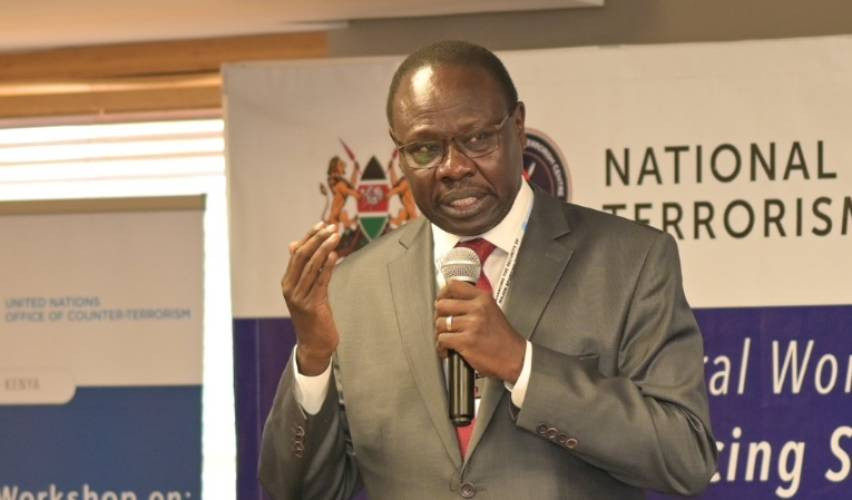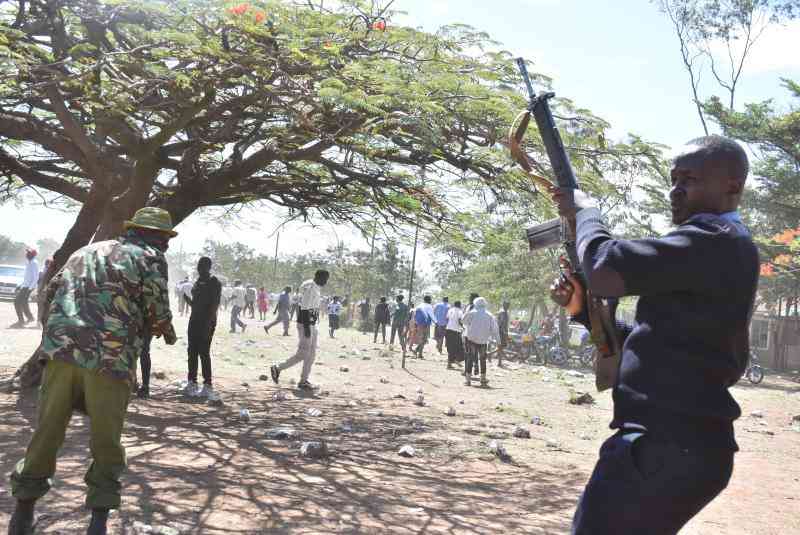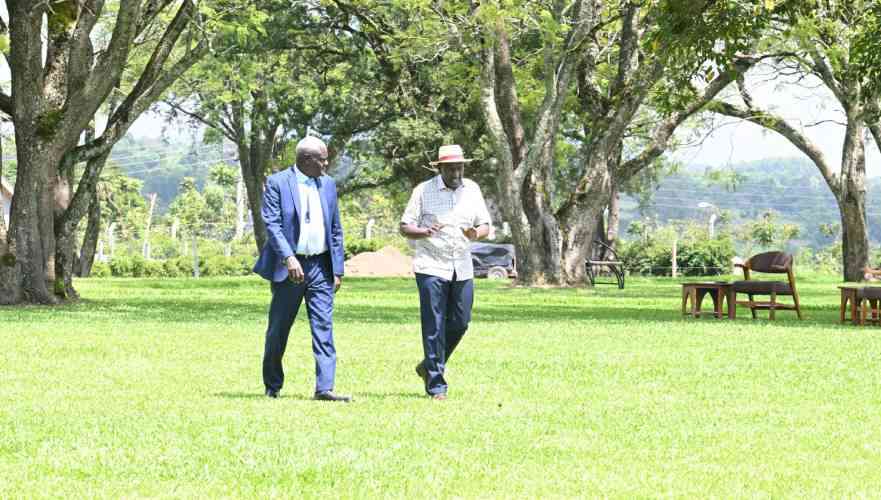At 8pm, June 15, 2014, a group of 50 Al-Shabaab militants walked into the dusty town of Mpeketoni and killed 48 people. A few weeks later, the group descended on Hindi, and killed more people, all of whom were non-Muslim.
Emboldened by the little resistance they had faced from Kenyan security officers during the attacks in Mpeketoni and Hindi, the militants moved to Pandanguo, a few days later. In Pandanguo, a predominantly Muslim village, the militants did not kill anyone.
Rather, they preached about ‘militant jihad’ at the local mosque, and looted drugs, nets and mattresses from the local dispensary. As Kenyan politicians began trading accusations over the events in Lamu, the militants collected their loot at Mpeketoni, Hindi and Pandanguo, and set up a new camp inside the vast Boni forest.
Since, members of this new Al-Shabaab force, dubbed ‘Jeysh Ayman’, or ‘Jeshi la Imani’, believed to be about 300, have engaged the Kenyan military in a cat and mouse game, in the Operation Linda Boni Forest, a joint-military operation aided by US special forces.
Along the Kenya-Somalia border, from Mandera to Lamu, and in particular, along the dusty Bargoni-Kiunga road that cuts through the Boni forest, Improvised Explosives Devices (IEDs) have claimed many lives – of civilians and soldiers alike.
The Aweer, a community of predominantly hunters and gatherers, and one of the oldest inhabitants of Boni forest, have been caught in the crossfire of the operation. When she was kidnapped along the Mokowe-Mpeketoni road – and later rescued by the KDF – Public Works Principal Secretary Mariam El-Maawy, was on her way to Witu town to see members of the Aweer community who have been displaced from their settlements by the operation, which now includes airstrikes.
Al-Shabaab’s latest offensive
The story of ‘Jeysh Ayman’ began on night of June 20, 2013, at the ancient Somali coastal town of Barawe, which had become Al-Shabaab’s operational headquarters after the group escaped Kismayu, their wealthy capital since 2006. During that night, militants attached to Al-Shabaab’s feared secret-police, the Amniyaat, executed Ibrahim Al-Afghani, a member of Al-Shabaab’s executive council, the Shura, on orders issued by the then Al-Shabaab leader, the late Ahmed Abdi Godane. Others, Mukhtar Robow and Sheikh Dahir Aweys, managed to escape, and later defected from Al-Shabaab.
While Godane had accused his colleagues of attempting to split Al-Shabaab and form rival organisations, his critics, such as Al-Afghani, Robow and Aweys, had accused him of dictatorial tendencies, and of unnecessarily shedding civilian blood. This conflict of opinion and strategy amongst Al-Shabaab’s top-leadership, which begun during Al-Shabaab’s heyday between 2006 and 2011, had escalated when the group lost huge swathes of territory to Amisom, whose numbers had been boosted by the entry of KDF into Southern Somalia in 2011.
After the Amisom onslaught, Godane’s strategy was to turn Al-Shabaab into a leaner, more ideologically unified outfit, that would launch a war of asymmetry and encourage spoiler insurgencies in Somalia, Ethiopia and Kenya.
Following in this strategy, Godane ordered his commander in the Lower and Middle Juba regions, Mohamed Kunow, to extend his operations into Garisa and Wajir counties in Kenya; while Kunow’s counterpart in the Gedo region of Somalia was ordered to begin attacks in Mandera County.
It was under this context that ‘Jeysh Ayman’, a military unit within Al-Shabaab, was established, composed of members from Kenya, Uganda and Tanzania, but dominated and led by Kenyan recruits. It was also under this context that Kenya witnessed the worst of Al-Shabaab attacks, beginning with the Westgate shopping mall attack of September 2013, followed by the Lamu massacre between June and July 2014, and the Garisa University killings in April 2015.
Pre-existing fault-lines
In fact, since 2010, a few months before the Kampala bombings in July, Godane had stated that he would use nationals of Somalia’s neighbours to wage war inside their countries of origin until their armies withdraw from Somalia. He said that these recruits ‘understand their own countries vulnerabilities intimately.’ And nowhere has Al-Shabaab shown their good understanding, and hence effective exploitation, of local vulnerabilities and pre-existing fault-lines than in Lamu County.
Host to three settlement schemes on its mainland, Lamu County, has historically been dominated by Muslim and coastal communities and a sizeable population of Christian and up-country families. This has not been a source of tension, but recent developments, especially government plans to construct a deep-water port on Manda bay, followed with a ‘port town’ in Hindi, an airport in Mpeketoni, and an Amusement park in Lamu island, heightened tensions around access to land in the county since 2012.
Stay informed. Subscribe to our newsletter
Kenyans from all over the country flocked to Lamu, when the Lapsset project was launched at Kililana, in search for land. Those who could not afford to buy simply squatted on idle land adjacent to the port site in the hope of some sort of government compensation.
These trends begun to revive old fault-lines, especially, the one between coastal communities and non-locals, with coastal communities arguing that they have been marginalised and excluded by the latter. This fault-line (and especially in Lamu) usually aligns with the religious cleavage between Christians and Muslims, where coastal communities also tend to be predominantly Muslim and vice-versa.
It was under this context that ‘Jeysh Ayman’, a force dominated by Kenyans from the neighbourhoods of Mombasa and Nairobi, and others from up-country Kenya, struck in Lamu, targeting the Christians residing on the mainland. In one of the statements issued by the militants during the attacks between June and July, 2014, they claimed that they were ‘rescuing Muslim lands from Christian invaders’.
Local political networks
This line strikes a familiar Kenyan chord, and in fact, it influenced a series of policy decisions (the most prominent one being the revocation of titles to 5,000 acres of land close to the proposed port site), including the argument, issued by the President, that the attack was the work of ‘local political networks.’ This belief, that the events in Lamu are not the work of Al-Shabaab, is evidence of the militants effective playing of common-place Kenyan understandings of how power and political violence works.
It also risks creating for Al-Shabaab a larger community of support within Kenya, as certain sections of the population receive blanket condemnation and blame for terrorist attacks. Most importantly, and perhaps, most worrying, is that this belief is building and boosting the audacity of the militants.
This was shown on the morning of June 15, 2015, the first anniversary of the Mpeketoni attacks, when an audacious attack by members of ‘Jeysh Ayman’ at a military camp in Baure in Lamu saw the killing of most of its original top leadership. The August 8 elections – can only present yet another opportunity for the group to engage in more terrifying acts.
- The writer is a PhD candidate in Durham University, UK
 The Standard Group Plc is a
multi-media organization with investments in media platforms spanning newspaper
print operations, television, radio broadcasting, digital and online services. The
Standard Group is recognized as a leading multi-media house in Kenya with a key
influence in matters of national and international interest.
The Standard Group Plc is a
multi-media organization with investments in media platforms spanning newspaper
print operations, television, radio broadcasting, digital and online services. The
Standard Group is recognized as a leading multi-media house in Kenya with a key
influence in matters of national and international interest.
 The Standard Group Plc is a
multi-media organization with investments in media platforms spanning newspaper
print operations, television, radio broadcasting, digital and online services. The
Standard Group is recognized as a leading multi-media house in Kenya with a key
influence in matters of national and international interest.
The Standard Group Plc is a
multi-media organization with investments in media platforms spanning newspaper
print operations, television, radio broadcasting, digital and online services. The
Standard Group is recognized as a leading multi-media house in Kenya with a key
influence in matters of national and international interest.








